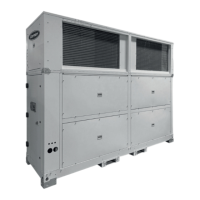35
15 - MAINTENANCE
15.1 General recommendations
To ensure optimal effi ciency and reliability of the equipment and
all its functions, we recommend taking out a maintenance contract
with the local organization set up by your manufacturer. This
contract will include regular inspections by the manufacturer’s
Service specialists so that any malfunction is detected and
corrected quickly, ensuring that no serious damage can occur.
The manufacturer’s service maintenance contract is the best
way to ensure the maximum operating life for your equipment
and, through the expertise of the manufacturer’s qualifi ed
personnel, provides the ideal way to manage your system energy
consumption eff ectively.
The refrigeration equipment must be serviced by professionals;
however, routine checks may be carried out locally by specially
trained technicians. Refer to EN 378-4 standard.
Note: Any deviation from or failure to comply with these
maintenance criteria will render the guarantee conditions for the
refrigeration unit null and void, and will release the manufacturer
from its liability.
All refrigerant charging, removal and draining operations
must be carried out by a qualifi ed technician, with the
correct equipment for the unit. Any inappropriate handling
can lead to uncontrolled fl uid or pressure leaks.
Before performing any work on the machine ensure
it is de-energized. Cut off the main power supply
with the door switch located in the electrical cabinet
of the outdoor module.
If a refrigerant circuit is opened, it must be
evacuated, recharged, and tested for leaks. Before
any operation on a refrigerant circuit, it is necessary
to evacuate the refrigerant charge from the device
using a charge transfer unit.
Simple preventive maintenance will allow you to get the best
performance from your refrigeration unit:
● Optimization of energy performance,
● Reduced electricity consumption.
● Prevention of accidental component failure.
● Prevention of major time-consuming and costly work.
● Protection of the environment.
The AFNOR NF X 60 010 standard can serve as a reference,
as it defi nes diff erent maintenance levels for refrigeration units.
15.2 Servicing
Level 1 maintenance
These simple procedures can be carried out by the user:
● Visual inspection for oil traces (sign of a refrigerant leak).
● Clean the air-cooled coils (see the dedicated section).
● Check the machine alarm report in case of malfunction (refer
to the control manual).
● Check for any general signs of deterioration.
● Check that the doors and panels are properly closed.
● Check the anti-corrosion coatings.
Level 2 maintenance
This level requires specifi c expertise in electrical, cooling, and
mechanical systems. It is possible that this expertise may be
available locally; there may be a maintenance service, industrial
site, or specialist subcontractor in the area.
The frequency of this maintenance level may be monthly or
annual, depending on the verifi cation type.
In these cases, the following maintenance operations are
recommended:
Carry out all level 1 operations, then:
Electrical checks (annual checks):
● At least once a year tighten the electrical connections for the
power supply circuits.
● Check and tighten all control connections, if required.
● Check the labeling of the system and instruments, re-apply
the missing labels if required.
● Remove the dust and clean the interior of the electrical boxes.
Be careful not to blow dust or debris into components; use a
brush and vacuum wherever possible.
● Clean the insulators and bus bar supports (dust combined with
moisture reduces the insulation gaps and increases current
leakage between phases and from phase to ground).
● Check the presence, condition, and operation of electrical
protective devices.
● Check the presence, condition, and operation of control
components.
● Check that all heaters are operating correctly.
● Replace the fuses every 3 years or every 15000 hours (aging).
● Check that no water has penetrated the electrical cabinet.
Mechanical checks:
● Check that the mounting bolts for the ventilation sub-
assemblies, fans, compressors, and electrical cabinet are
securely tightened
Refrigerant circuit checks:
● The unit is subject to F-gas tight regulatory checks.
● Check the unit operating parameters and compare them with
the previous values.
● Check the operation of the high-pressure switches. Replace
them if there is a fault.
● Check the fouling of the filter driers. Replace them if
necessary.
● Keep an up-to-date service booklet specifi c to the refrigeration
unit in question.
Ensure all adequate safety measures are taken for
all these operations: use appropriate PPE (personal
protective equipment), comply with all industry and
local regulations, use common sense.

